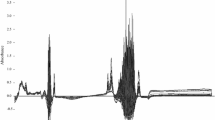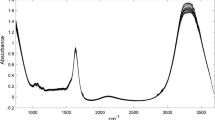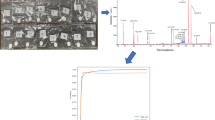Abstract
In the present study, near-infrared spectroscopy (NIRS) was explored as a fast and reliable screening method for the detection of adulteration of skim milk powder (SMP). Sixty genuine SMP were adulterated with acid whey (1–25 % w/w), starch (2 and 5 %) and maltodextrin (2 and 5 %) for a total of 348 adulterated samples. Two chemometric approaches were employed. In the first approach, an untargeted one class model for genuine skim milk powder was developed by Soft Independent Modelling of Class Analogy. In the second approach, adulterant-specific regression models were developed to assess the amount of each adulterant by partial least square regression and principal component regression. The class modelling approach had the advantage that several adulterants could be detected with the same chemometric model, including situations where multiple adulterants are present in the test sample or where yet unknown adulterants are present. Regression models showed a better sensitivity with genuine SMP samples completely discriminated from samples adulterated with 5 % acid whey and 2 % of starch or maltodextrin. NIRS proved to be a useful tool for the rapid and cost-efficient untargeted and/or targeted detection of adulterations in SMP.






Similar content being viewed by others
References
Baer RJ, Frank JF, Loewenstein M (1983) Compositional analysis of nonfat dry milk by using near infrared diffuse reflectance spectroscopy. JAOAC 66:858–863
Balabin RM, Smirnov SV (2011) Melamine detection by mid- and near-infrared (MIR/NIR) spectroscopy: a quick and sensitive method for dairy products analysis including liquid milk, infant formula, and milk powder. Talanta 85:562–568
Barton FE II (2002) Theory and principles of near infrared spectroscopy. Spectrosc Eur 14(1):2–18
Banks W, Greenwoo CT, Muir DD (1971) The characterization of starch and its components. Part 3. The technique of semi-micro, differential, potentiometric, iodine titration, and the factors affecting it. Starch/Starke 23:118–124
Basch JD, Procino FW, Holsinger LG, Farrell HM Jr (1985) Quantitation of caseins and whey proteins of processed milks and whey protein concentrates, application of gel electrophoresis, and comparison with Harland-Ashworth procedure. J Dairy Sci 68:23–31
Borin A, Ferrão MF, Mello C, Maretto DA, Poppi RJ (2006) Least-squares support vector machines and near infrared spectroscopy for quantification of common adulterants in powdered milk. Anal Chim Acta 579:25–32
Botros LL, Jablonski J, Chang C, Bergana MM, Wehling P, Harnly JM, Downey G, Harrington P, Potts AR, Moore JC (2013) Exploring authentic skim and nonfat dry milk powder variance for the development of nontargeted adulterant detection methods using near-infrared spectroscopy and chemometrics. J Agric Food Chem 61:9810–9818
Cartuyvels D, Merchiers M, Van Renterghem R, De Block J (1999) A fast and simple method to determine the whey powder to milk powder ratio using spectroscopy in alkali. Milchwissenschaft 54:268–272
Chavez NA, Salinas E, Jauregui J, Palomares LA, Macias K (2008) Detection of bovine milk adulterated with cheese whey by Western blot immunoassay. Food Agric immunol 19:265–272
Cozzolino D (2012) Recent trends on the use of infrared spectroscopy to trace and authenticate natural and agricultural food products. Appl Spectrosc Rev 47(7):518–530
De Block J, Merchiers M, Van Renterghem R (1997) Quantification of the ratio of whey powder to milk powder using spectroscopy in alkali. Milchwissenschaft 52:213–216
De Koning PJ, Van Rooijen PJ (1971) Estimation of whey proteins in casein co-precipitate or in mixtures with milk powder by the use of a modified ninhydrin reaction. Milchwissenschaft 26:1–6
Ferrão MF, Mello C, Borin A, Maretto DA, Poppi RJ (2007) LS-SVM: a new chemometric tool for multivariate regression. Comparison of LS-SVM and PLS regression for determination of common adulterants in powdered milk by NIR spectroscopy. Quim Nova 30:852–859
Gorry PA (1990) General least-squares smoothing and differentiation by the convolution (Savitzky-Golay) method. Anal Chem 62:570–573
Kanning M, Casella M, Olieman C (1993) Milk and soy proteins analysis using capillary zone electrophoresis. LCGC Int 6:701–706
Lechner E, Klostermeyer H (1981) Nachweis einer VerfaKlschung von magermilchpulver mit molkenpulver (polarographische methode). Milchwissenschaft 36:267–270
Lu C, Xiang B, Hao G, Xu J, Wang Z, Chen C (2009) Rapid detection of melamine in milk powder by near infrared spectroscopy. J Near Infrared Spectrosc 17:59–67
Lüthi-Peng QQ, Puhan Z (1999) The 4th derivative spectroscopic method for the rapid determination of protein and casein in milk. Milchwissenschaft 54:74–77
Maraboli A, Cattaneo T, Giangiacomo R (2002) Detection of vegetable proteins from soy, pea and wheat isolates in milk powder by near infrared spectroscopy. J Near Infrared Spectrosc 10:63–69
Mendenhall IV, Brown RJ (1991) Fourier transform infrared determination of whey powder in nonfat dry milk. J Dairy Sci 74:2896–2900
Meisel H (1995) Application of fourth derivative spectroscopy to quantitation of whey protein and casein in total milk protein. Milchwissenschaft 50:247–251
Miller CE (1989) Chemical principles of near-infrared technology. In: Williams P, Norris K (eds) Near infrared technology in the agricultural and food industries. American Association of Cereal Chemists, St.Paul (MN)
Miralles B, Bartolomé B, Ramos M, Amigo L (2000) Determination of whey protein to total protein ratio in UHT milk using fourth derivative spectroscopy. Int Dairy J 10:191–197
Ni Z, Feng YC, Hu CQ (2010) Analyzing the methods to remove artifacts encountered in the development of a NIR quantitative model for powder medicines. J Anal Bioanalytical Techniques 1:114–120
Osborne BG (2000) Near-infrared spectroscopy in food analysis. Wiley, Chichester, UK
Rocklin RD, Pohl CA (1983) Determination of carbohydrates by anion exchange chromatography with pulsed amperometric detection. J Liq Chromatogr 6:1577–1590
Rodriguez-Saona LE, Allendorf ME (2011) Use of FTIR for rapid authentication and detection of adulteration of food. Annu Rev Food Sci Technol 2:467–483
Sanvido G, Garcia JG, Corilo YE, Vaz BG, Zacca JJ, Cosso RG, Eberlin MN, Peter MG (2010) Fast screening and secure confirmation of milk powder adulteration with MD via electrospray ionization-mass spectrometry [ESI(þ)-MS] and selective enzymatic hydrolysis. J Agric Food Chem 58:9407–9412
Savitzky A, Golay MJE (1964) Smoothing and differentiation of data by simplified least squares procedures. Anal Chem 36:1627–1639
Storz E, Steffens K-J (2004) Feasibility study for determination of the dextrose equivalent (DE) of starch hydrolysis products with near-infrared spectroscopy (NIRS). Starch/Stärke 56:58–62
Vogelgesang J, Hädrich J (1998) Limits of detection, identification and quantification: a statistical approach for practitioners. Accredit Qual Assur 3:242–255
Acknowledgments
The authors gratefully acknowledge the Dutch Ministry of Economic Affairs and Innovation for financial support.
Conflict of Interest
Edoardo Capuano declares that he has no conflict of interest. Rita Boerrigter-Eenling declares that she has no conflict of interest. Alex Koot declares that he has no conflict of interest. Saskia M van Ruth declares that she has no conflict of interest. This article does not contain any studies with human or animal subjects.
Author information
Authors and Affiliations
Corresponding author
Rights and permissions
About this article
Cite this article
Capuano, E., Boerrigter-Eenling, R., Koot, A. et al. Targeted and Untargeted Detection of Skim Milk Powder Adulteration by Near-Infrared Spectroscopy. Food Anal. Methods 8, 2125–2134 (2015). https://doi.org/10.1007/s12161-015-0100-3
Received:
Accepted:
Published:
Issue Date:
DOI: https://doi.org/10.1007/s12161-015-0100-3




